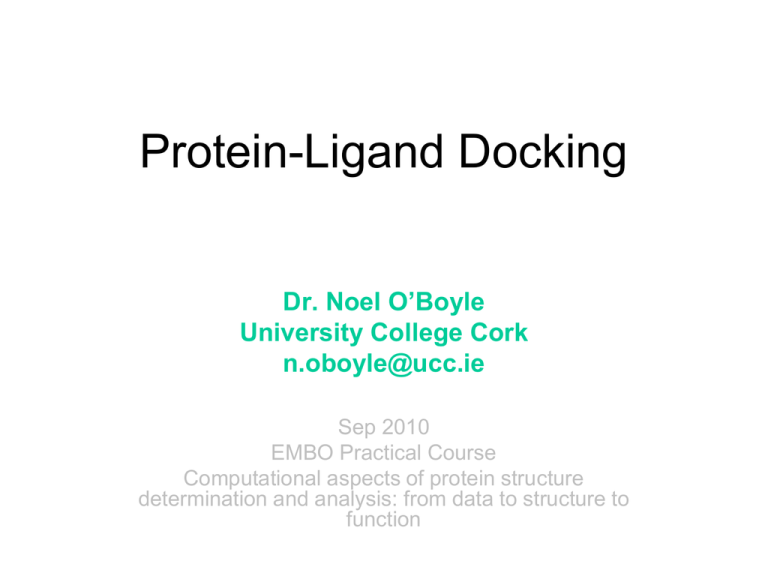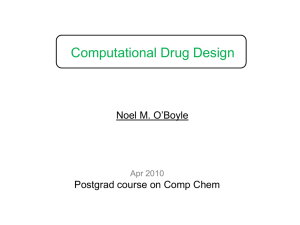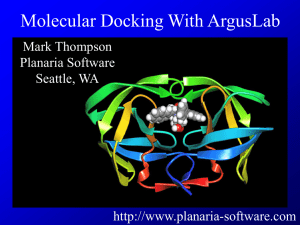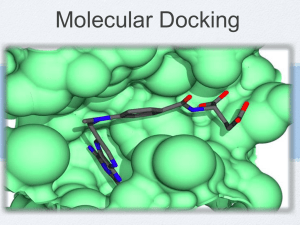Protein-Ligand Docking
advertisement

Protein-Ligand Docking Dr. Noel O’Boyle University College Cork n.oboyle@ucc.ie Sep 2010 EMBO Practical Course Computational aspects of protein structure determination and analysis: from data to structure to function Outline • • • • • Introduction to protein-ligand docking Practical aspects Searching for poses Scoring functions Assessing performance Outline • • • • • Introduction to protein-ligand docking Practical aspects Searching for poses Scoring functions Assessing performance Unknown protein structure Known protein structure Computer-aided drug design (CADD) Known ligand(s) No known ligand Structure-based drug design (SBDD) De novo design Protein-ligand docking Ligand-based drug design (LBDD) 1 or more ligands • Similarity searching Several ligands • Pharmacophore searching Many ligands (20+) • Quantitative Structure-Activity Relationships (QSAR) CADD of no use Need experimental data of some sort Protein-ligand docking • A Structure-Based Drug Design (SBDD) method – “structure” means “using protein structure” • Computational method that mimics the binding of a ligand to a protein • Given... • Predicts... • The pose of the molecule in the binding site • The binding affinity or a score representing the strength of binding Pose vs. binding site • Binding site (or “active site”) – the part of the protein where the ligand binds – generally a cavity on the protein surface – can be identified by looking at the crystal structure of the protein bound with a known inhibitor • Pose (or “binding mode”) – The geometry of the ligand in the binding site – Geometry = location, orientation and conformation • Protein-ligand docking is not about identifying the binding site Uses of docking • The main uses of protein-ligand docking are for – Virtual screening, to identify potential lead compounds from a large dataset (see next slide) – Pose prediction • Pose prediction • If we know exactly where and how a known ligand binds... – We can see which parts are important for binding – We can suggest changes to improve affinity – Avoid changes that will ‘clash’ with the protein Virtual screening • Virtual screening is the computational or in silico analogue of biological screening • The aim is to score, rank or filter a set of chemical structures using one or more computational procedures – Docking is just one way to do this • It can be used – – – – to help decide which compounds to screen (experimentally) which libraries to synthesise which compounds to purchase from an external company to analyse the results of an experiment, such as a HTS run Components of docking software • Typically, protein-ligand docking software consist of two main components which work together: • 1. Search algorithm – Generates a large number of poses of a molecule in the binding site • 2. Scoring function – Calculates a score or binding affinity for a particular pose • To give: • The pose of the molecule in the binding site • The binding affinity or a score representing the strength of binding Final points • Large number of docking programs available – AutoDock, DOCK, e-Hits, FlexX, FRED, Glide, GOLD, LigandFit, QXP, Surflex-Dock…among others – Different scoring functions, different search algorithms, different approaches – See Section 12.5 in DC Young, Computational Drug Design (Wiley 2009) for good overview of different packages • Note: protein-ligand docking is not to be confused with the field of protein-protein docking (“protein docking”) Outline • • • • • Introduction to protein-ligand docking Practical aspects Searching for poses Scoring functions Assessing performance Preparing the protein structure • PDB structures often contain water molecules – In general, all water molecules are removed except where it is known that they play an important role in coordinating to the ligand • PDB structures are missing all hydrogen atoms – Many docking programs require the protein to have explicit hydrogens. In general these can be added unambiguously, except in the case of acidic/basic side chains • An incorrect assignment of protonation states in the active site will give poor results • Glutamate, Aspartate have COO- or COOH – OH is hydrogen bond donor, O- is not • Histidine is a base and its neutral form has two tautomers N NH HN R R HN R N + NH Preparing the protein structure • For particular protein side chains, the PDB structure can be incorrect • Crystallography gives electron density, not molecular structure – In poorly resolved crystal structures of proteins, isoelectronic groups can give make it difficult to deduce the correct structure O R NH2 R NH 2 N R R O N N N • Affects asparagine, glutamine, histidine • Important? Affects hydrogen bonding pattern • May need to flip amide or imidazole – How to decide? Look at hydrogen bonding pattern in crystal structures containing ligands Ligand Preparation • A reasonable 3D structure is required as starting point – During docking, the bond lengths and angles in ligands are held fixed; only the torsion angles are changed • The protonation state and tautomeric form of a particular ligand could influence its hydrogen bonding ability – Either protonate as expected for physiological pH and use a single tautomer – Or generate and dock all possible protonation states and tautomers, and retain the one with the highest score OH Enol H+ O Ketone Outline • • • • • Introduction to protein-ligand docking Practical aspects Searching for poses Scoring functions Assessing performance The search space • The difficulty with protein–ligand docking is in part due to the fact that it involves many degrees of freedom – The translation and rotation of one molecule relative to another involves six degrees of freedom – There are in addition the conformational degrees of freedom of both the ligand and the protein – The solvent may also play a significant role in determining the protein–ligand geometry (often ignored though) • The search algorithm generates poses, orientations of particular conformations of the molecule in the binding site – Tries to cover the search space, if not exhaustively, then as extensively as possible – There is a tradeoff between time and search space coverage Ligand conformations • Conformations are different three-dimensional structures of molecules that result from rotation about single bonds – That is, they have the same bond lengths and angles but different torsion angles • For a molecule with N rotatable bonds, if each torsion angle is rotated in increments of θ degrees, number of conformations is (360º/ θ)N – If the torsion angles are incremented in steps of 30º, this means that a molecule with 5 rotatable bonds with have 12^5 ≈ 250K conformations • Having too many rotatable bonds results in “combinatorial explosion” • Also ring conformations Taxol Search Algorithms • We can classify the various search algorithms according to the degrees of freedom that they consider • Rigid docking or flexible docking – With respect to the ligand structure • Rigid docking • The ligand is treated as a rigid structure during the docking – Only the translational and rotational degrees of freedom are considered • To deal with the problem of ligand conformations, a large number of conformations of each ligand are generated in advance and each is docked separately • Examples: FRED (Fast Rigid Exhaustive Docking) from OpenEye, and one of the earliest docking programs, DOCK The DOCK algorithm – Rigid docking • The DOCK algorithm developed by Kuntz and co-workers is generally considered one of the major advances in protein–ligand docking [Kuntz et al., JMB, 1982, 161, 269] • The earliest version of the DOCK algorithm only considered rigid body docking and was designed to identify molecules with a high degree of shape complementarity to the protein binding site. • The first stage of the DOCK method involves the construction of a “negative image” of the binding site consisting of a series of overlapping spheres of varying radii, derived from the molecular surface of the protein AR Leach, VJ Gillet, An Introduction to Cheminformatics The DOCK algorithm – Rigid docking • Ligand atoms are then matched to the sphere centres so that the distances between the atoms equal the distances between the corresponding sphere centres, within some tolerance. • The ligand conformation is then oriented into the binding site. After checking to ensure that there are no unacceptable steric interactions, it is then scored. • New orientations are produced by generating new sets of matching ligand atoms and sphere centres. The procedure continues until all possible matches have been considered. AR Leach, VJ Gillet, An Introduction to Cheminformatics Flexible docking • Flexible docking is the most common form of docking today – Conformations of each molecule are generated on-the-fly by the search algorithm during the docking process – The algorithm can avoid considering conformations that do not fit • Exhaustive (systematic) searching computationally too expensive as the search space is very large • One common approach is to use stochastic search methods – These don’t guarantee optimum solution, but good solution within reasonable length of time – Stochastic means that they incorporate a degree of randomness – Such algorithms include genetic algorithms (GOLD), simulated annealing (AutoDock) • An alternative is to use incremental construction methods – These construct conformations of the ligand within the binding site in a series of stages – First one or more “base fragments” are identified which are docked into the binding site – The orientations of the base fragment then act as anchors for a systematic conformational analysis of the remainder of the ligand – Example: FlexX Handling protein conformations • Most docking software treats the protein as rigid – Rigid Receptor Approximation • This approximation may be invalid for a particular protein-ligand complex as... – the protein may deform slightly to accommodate different ligands (ligand-induced fit) – protein side chains in the active site may adopt different conformations • Some docking programs allow protein side-chain flexibility – For example, selected side chains are allowed to undergo torsional rotation around acyclic bonds – Increases the search space • Larger protein movements can only be handled by separate dockings to different protein conformations • Ensemble docking (e.g. GOLD 5.0) Outline • • • • • Introduction to protein-ligand docking Practical aspects Searching for poses Scoring functions Assessing performance Components of docking software • Typically, protein-ligand docking software consist of two main components which work together: • 1. Search algorithm – Generates a large number of poses of a molecule in the binding site • 2. Scoring function – Calculates a score or binding affinity for a particular pose • To give: • The pose of the molecule in the binding site • The binding affinity or a score representing the strength of binding The perfect scoring function will… • Accurately calculate the binding affinity – Will allow actives to be identified in a virtual screen – Be able to rank actives in terms of affinity • Score the poses of an active higher than poses of an inactive – Will rank actives higher than inactives in a virtual screen • Score the correct pose of the active higher than an incorrect pose of the active – Will allow the correct pose of the active to be identified • “actives” = molecules with biological activity Classes of scoring function • Broadly speaking, scoring functions can be divided into the following classes: – Forcefield-based • Based on terms from molecular mechanics forcefields • GoldScore, DOCK, AutoDock – Empirical • Parameterised against experimental binding affinities • ChemScore, PLP, Glide SP/XP – Knowledge-based potentials • Based on statistical analysis of observed pairwise distributions • PMF, DrugScore, ASP Empirical scoring functions Böhm’s empirical scoring function • In general, scoring functions assume that the free energy of binding can be written as a linear sum of terms to reflect the various contributions to binding • Bohm’s scoring function included contributions from hydrogen bonding, ionic interactions, lipophilic interactions and the loss of internal conformational freedom of the ligand. • • The ∆G values on the right of the equation are all constants (see next slide) ∆Go is a contribution to the binding energy that does not directly depend on any specific interactions with the protein The hydrogen bonding and ionic terms are both dependent on the geometry of the interaction, with large deviations from ideal geometries (ideal distance R, ideal angle α) being penalised. The lipophilic term is proportional to the contact surface area (Alipo) between protein and ligand involving non-polar atoms. The conformational entropy term is the penalty associated with freezing internal rotations of the ligand. It is largely entropic in nature. Here the value is directly proportional to the number of rotatable bonds in the ligand (NROT). • • • Böhm’s empirical scoring function • This scoring function is an empirical scoring function – Empirical = incorporates some experimental data • The coefficients (∆G) in the equation were determined using multiple linear regression on experimental binding data for 45 protein–ligand complexes • Although the terms in the equation may differ, this general approach has been applied to the development of many different empirical scoring functions Knowledge-based potentials • Statistical potentials • Based on a comparison between the observed number of contacts between certain atom types (e.g. sp2-hybridised oxygens in the ligand and aromatic carbons in the protein) and the number of contacts one would expect if there were no interaction between the atoms (the reference state) • Derived from an analysis of pairs of non-bonded interactions between proteins and ligands in PDB – Observed distributions of geometries of ligands in crystal structures are used to deduce the potential that gave rise to the distribution – Hence “knowledge-based” potential Knowledge-based potentials For example, creating the distributions of ligand carbonyl oxygens to protein hydroxyl groups: Ligand Ligand Ligand O O O HO HO Protein HO Protein Protein (imagine the minimum at 3.0Ang) (Invented) distribution of a particular pairwise interaction 1000 800 600 400 200 Distance (Angstrom) 5 4. 5 4 3. 5 3 2. 5 2 1. 5 1 0. 5 0 0 Number of observations 1200 Knowledge-based potentials • Some pairwise interactions may occur seldom in the PDB – Resulting distribution may be inaccurate • Doesn’t take into account directionality of interactions, e.g. hydrogen bonds – Just based on pairwise distances • Resulting score contains contributions from a large number of pairwise interactions – Difficult to identify problems and to improve • Sensitive to definition of reference state – DrugScore has a different reference state than ASP (Astex Statistical Potential) Outline • • • • • Introduction to protein-ligand docking Practical aspects Searching for poses Scoring functions Assessing performance Pose prediction accuracy • Given a set of actives with known crystal poses, can they be docked accurately? • Accuracy measured by RMSD (root mean squared deviation) compared to known crystal structures – RMSD = square root of the average of (the difference between a particular coordinate in the crystal and that coordinate in the pose)2 – Within 2.0Å RMSD considered cut-off for accuracy – More sophisticated measures have been proposed, but are not widely adopted • In general, the best docking software predicts the correct pose about 70% of the time • Note: it’s always easier to find the correct pose when docking back into the active’s own crystal structure – More difficult to cross-dock AR Leach, VJ Gillet, An Introduction to Cheminformatics Assess performance of a virtual screen • Need a dataset of Nact known actives, and inactives • Dock all molecules, and rank each by score • Ideally, all actives would be at the top of the list – In practice, we are interested in any improvement over what is expected by chance • Define enrichment, E, as the number of actives found (Nfound) in the top X% of scores (typically 1% or 5%), compared to how many expected by chance – E = Nfound / (Nact * X/100) – E > 1 implies “positive enrichment”, better than random – E < 1 implies “negative enrichment”, worse than random • Why use a cut-off instead of looking at the mean rank of the actives? – Typically, the researchers might test only have the resources to experimentally test the top 1% or 5% of compounds • More sophisticated approaches have been developed (e.g. BEDROC) but enrichment is still widely used Final thoughts • Protein-ligand docking is an essential tool for computational drug design – Widely used in pharmaceutical companies – Many success stories (see Kolb et al. Curr. Opin. Biotech., 2009, 20, 429) • But it’s not a golden bullet – The perfect scoring function has yet to be found – The performance varies from target to target, and scoring function to scoring function • See for example, Plewczynski et al, “Can we trust docking results? Evaluation of seven commonly used programs on PDBbind database”, J. Comp. Chem., Online 1 Sep 2010. • Care needs to be taken when preparing both the protein and the ligands • The more information you have (and use!), the better your chances – Targeted library, docking constraints, filtering poses, seeding with known actives, comparing with known crystal poses Questions? Protein-Ligand Docking Dr. Noel O’Boyle University College Cork n.oboyle@ucc.ie Sep 2010 EMBO Practical Course Computational aspects of protein structure determination and analysis: from data to structure to function





